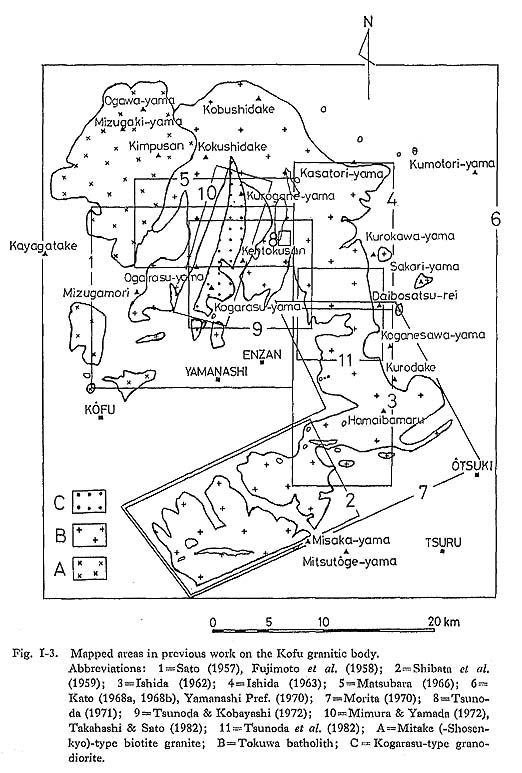CHAPTER I
Introdution
|
Since the discussion between the schools of Mutton and Werner in the 18th century, tremendous efforts have been made to clarify the genesis of granitoids. Two basic contradictory theories have been proposed to explain the origin of granitoids: the metamorphic and the magmatic theories. Intimate association of granitoids and metamorphic rocks such as gneiss in regionally metamorphic terrains has led many petrologists to consider granitoids as a kind of metamorphic or metasomatic rock (e.g., Holmquist, 1921; Sederholm, 1923; Reynolds, 1934). Another group of petrologists consider granitoids to be rocks formed by the differentiation of magmas (e.g., Goldschmidt, 1922; Bowen, 1928, 1948; Holmes, 1932). The intrusive character of some granitoids has been postulated (e.g., Rosenbusch, 1877) and the importance of the assimilation by country rocks into granitic magma has also been argued (e.g., Daly, 1912; Bowen, 1922; Nockolds, 1933). A third group rejects neither of the two theories stated above (e.g., Eskola, 1932; Wegmann, 1935; Read, 1957). Numerous individual plutons seems to have their own evolutionary histories; as succinctly put by Read (1948): "There are granites and granites." One point of interest with respect to the granite problem is the criteria by which we judge whether a given granitoid is derived from metamorphosed sediments or from magmas generated in the great depths of the earth's crust by partial fusion of the lower crust or by subducting slabs. Recently, there has been progress in resolving the problem of the genesis of granitoids. For instance, Chappell, White, and their co-workers have clarified that there is a comositional difference between granitoids in which metamorphosed sediments played a principal role in their genesis and those which can be considered of magmatic origin. They thus proposed distinctions between S-type and I-type granitoids: presence or absence of aluminosilicates such as muscovite, chemical properties such as the content of normative corundum, values of the initial 87Sr/86Sr ratio and 18O/16O ratio, and difference in mineralization (tin or porphyry-copper) (Chappell and White, 1974). Ishihara and his collaborators also empirically determined the existence of two types of granitoids: those containing only ilmenite as a primarily formed Fe-Ti oxide mineral and those containing magnetite and ilmenite. They showed differences in ore deposits related to magnetite-bearing (magnetite-series) granitoids and those related to magnetite-free (ilmenite-series) granitoids (Ishihara, 1977). Takahashi et al. (1980) have presented the relation between I-type and S-type granitoids versus magnetite-series and ilmenite-series granitoids on the basis of whole-rock chemistry, and concluded that the majority of the Japanese magnetite-series and ilmenite-series granitoids can be classified as I-type granitoids. There are some examples in which two series of granitoids occur within a single batholith; the Hobenzan granitic complex (Nakashima et al., 1984), the Miyako granitic body (Ishihara, pers. comm.), the Chichibu granitic body (Takahashi, pers. comm.), and the Tokuwa batholith. Among these, the Tokuwa batholith appears the most suitable for study because it has the largest and the best exposures. It is situated to the east of the Kofu Basin, Yamanashi Prefecture, about 120 km west of Tokyo, central Japan (Fig. I-1).
Figure I-2 shows the distribution of Neogene granitoids in central Japan, in which B denotes the Kofu granitic body. The Kofu granitic body is divided into three masses, mainly based on lithological characters and the results of age determinations. The Tokuwa batholith, whose total outcrop is about 300 km2, measuring 42 km north-south and 26 km across, constitutes the principal part of the Kofu granitic body (Fig. I-3). The Tokuwa batholith intruded sedimentary rocks of the Shimanto Supergroup and the Kobotoke Group in the Shimanto Belt and the Misaka and Nishikatsura Groups in the Green Tuff region. The two scries of the Tokuwa batholith rocks, together with their surroundings, were subjected to geological, geochemical, petrological, and mineralogical studies to clarify their characteristics and to reveal the genesis of the batholithic rocks.
|


